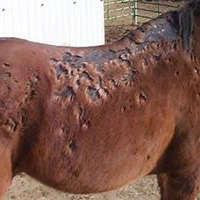How to Treat and Prevent Rain Scald on Horses
Rain Scald, also known as mud fever or rain rot is a bacterial, in some cases even fungal infection caused by a bacteria called Dermatophilus congolensis that is triggered by heavy, persistent rain and seldom fly bites.
Horses get affected by this infection during rainy, wet seasons, mainly appearing on their heels, pasterns and lower legs. (Cannon bone) But sometimes, if it's been raining enough and a horse is left out in the rain without shelter and no blanket, rain scald will affect the body of the horse, such as their back and rump. This is very bad as the scabs on the horse's back are painful for the horse, especially if someone were to then go hop onto the horse and ride him, which I hope no one would.
Rain Scald can even affect the horse's face such as their muzzle area and around the eyes and ears.
When wet mud or water sits on the horse's leg/s for a few days, the bacteria develops on their leg/s, creating bare patches where the skin is visible. Over time, scabs develop over the raw skin.
Rain Scald is not a very nice skin infection, and it doesn't leave without treatment. So, here are a few ways to treat Rain Scald:
#1. Coconut oil.
Who would have even thought that coconut oil cures Rain Scald, well it sure does! Coconut acts as a waterproofing agent and will help to keep moisture away from the scabs. All you need to do is gently rub the coconut oil into the affected area on the skin. It can also be rubbed onto the bare batches of skin. The Coconut oil will prevent the bacteria from growing on the skin. After a while, after applying the coconut oil on the damaged area daily, any scabs should lift and you will be able to easily brush the scabs off with a brush without any effort or causing any pain to the horse.
#2. Dry, clean footing.
If your horse's hooves (and around the pasterns) were affected, providing dry, clean footing is very important. If you leave your horse out in the wet even when you have realized that rain scald has developed, the chances are, the rain scald will get even worse and the patches of bare skin bigger, and eventually get really sore and itchy.
#3. Shampoo.
There are special types of shampoos you can use specifically for treating rain scald. Applying that regularly will eventually prevent the bacteria from growing on the skin.
Okay so now that we've discussed how to treat Rain Scald, now I'll list ways you can prevent this nasty infection:
- Make sure your horse has quick and easy access to shelter.
-Make sure your horse has access to dry footing, such as in their shelter. (Whether that be a run-in shelter or a fully enclosed shelter.)
-General cleanliness. Bacteria also grow in dusty, dirty areas. So making sure your horse's yard or stable is kept clean is also important.
-Good ventilation.
-Always remember to use a sweat scraper on your horse's body after you have given him wash or rinse. Never leave him with water falling down his sides.
Fact: Horses with white legs are more susceptible to rain scald.
I hope this article helped you, and you learnt a thing or two! If you have any questions, make sure to just comment down below! Thanks. :)
If your horse is suspected with a health issue, consult your vet straight away.
google.com, pub-8232596071931364, DIRECT, f08c47fec0942fa0



Comments